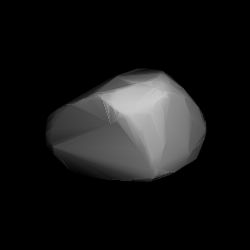Astronomy:8187 Akiramisawa
 Akiramisawa modeled from its lightcurve | |
| Discovery [1][2] | |
|---|---|
| Discovered by | S. Otomo |
| Discovery site | Kiyosato Obs. (894) |
| Discovery date | 15 December 1992 |
| Designations | |
| (8187) Akiramisawa | |
| Named after | Akira Misawa (Japanese botanist)[3] |
| 1992 XL · 1971 UF4 1971 VV | |
| Minor planet category | main-belt [1][2] · (outer) [4] Eos [5] |
| Orbital characteristics [2] | |
| Epoch 4 September 2017 (JD 2458000.5) | |
| Uncertainty parameter 0 | |
| Observation arc | 44.79 yr (16,358 days) |
| |{{{apsis}}}|helion}} | 3.3523 AU |
| |{{{apsis}}}|helion}} | 2.6219 AU |
| 2.9871 AU | |
| Eccentricity | 0.1223 |
| Orbital period | 5.16 yr (1,886 days) |
| Mean anomaly | 351.90° |
| Mean motion | 0° 11m 27.24s / day |
| Inclination | 11.608° |
| Longitude of ascending node | 83.066° |
| 277.60° | |
| Physical characteristics | |
| Mean diameter | 11.86 km (calculated)[4] |
| Rotation period | 5.8153±0.0015 h[6] |
| Geometric albedo | 0.057 (assumed)[4] |
| C (assumed)[4] | |
| Absolute magnitude (H) | 12.8[2] · 13.45±0.27[7] · 12.908±0.007 (R)[6] · 13.36[4] |
8187 Akiramisawa, provisional designation 1992 XL, is an Eos asteroid from the outer region of the asteroid belt. It was discovered by Japanese astronomer Satoru Otomo at Kiyosato Observatory (894) on 15 December 1992.[1] The assumed C-type asteroid has a rotation period of 5.8 hours and measures approximately 12 kilometers (7.5 miles) in diameter. It was named after Japanese botanist Akira Misawa (1942–1994).[3]
Orbit and classification
Akiramisawa is a member the Eos family (606),[5] the largest asteroid family of the outer main belt consisting of nearly 10,000 known members.[8]:23 It orbits the Sun in the outer asteroid belt at a distance of 2.6–3.4 AU once every 5 years and 2 months (1,886 days). Its orbit has an eccentricity of 0.12 and an inclination of 12° with respect to the ecliptic.[2] In October 1971, it was first identified as 1971 UF4 at the Chilean Cerro El Roble Station, extending the body's observation arc by 21 years prior to its official discovery observation at Kiyosato.[1]
Naming
This minor planet was named in honour of Japanese botanist Akira Misawa (1942–1994), a professor at Chiba University , who examined the effects of light pollution on plants.[3] The official naming citation was published by the Minor Planet Center on 9 January 2001 (M.P.C. 41935).[9]
Physical characteristics
A rotational lightcurve of Akiramisawa was obtained from photometric observations made at the Palomar Transient Factory in June 2010. Lightcurve analysis gave a rotation period of 5.8153±0.0015 hours with a high brightness amplitude of 0.90 magnitude ({{{1}}}).[6] The Collaborative Asteroid Lightcurve Link assumes a standard albedo for carbonaceous asteroids of 0.057, and calculates a diameter of 11.9 kilometers with an absolute magnitude of 13.36.[2]
References
- ↑ Jump up to: 1.0 1.1 1.2 1.3 "8187 Akiramisawa (1992 XL)". Minor Planet Center. https://www.minorplanetcenter.net/db_search/show_object?object_id=8187.
- ↑ Jump up to: 2.0 2.1 2.2 2.3 2.4 2.5 "JPL Small-Body Database Browser: 8187 Akiramisawa (1992 XL)". Jet Propulsion Laboratory. https://ssd.jpl.nasa.gov/sbdb.cgi?sstr=2008187.
- ↑ Jump up to: 3.0 3.1 3.2 Schmadel, Lutz D. (2007). "(8187) Akiramisawa". Dictionary of Minor Planet Names. Springer Berlin Heidelberg. p. 637. doi:10.1007/978-3-540-29925-7_6888. ISBN 978-3-540-00238-3. https://archive.org/details/dictionaryminorp00schm.
- ↑ Jump up to: 4.0 4.1 4.2 4.3 4.4 "LCDB Data for (8187) Akiramisawa". Asteroid Lightcurve Database (LCDB). http://www.minorplanet.info/PHP/generateOneAsteroidInfo.php?AstInfo=8187%7CAkiramisawa.
- ↑ Jump up to: 5.0 5.1 "Asteroid 8187 Akiramisawa – Nesvorny HCM Asteroid Families V3.0". Small Bodies Data Ferret. https://sbntools.psi.edu/ferret/SimpleSearch/results.action?targetName=8187+Akiramisawa#Asteroid%208187%20AkiramisawaEAR-A-VARGBDET-5-NESVORNYFAM-V3.0.
- ↑ Jump up to: 6.0 6.1 6.2 Waszczak, Adam; Chang, Chan-Kao; Ofek, Eran O.; Laher, Russ; Masci, Frank; Levitan, David et al. (September 2015). "Asteroid Light Curves from the Palomar Transient Factory Survey: Rotation Periods and Phase Functions from Sparse Photometry". The Astronomical Journal 150 (3): 35. doi:10.1088/0004-6256/150/3/75. Bibcode: 2015AJ....150...75W. http://adsabs.harvard.edu/cgi-bin/bib_query?bibcode=2015AJ....150...75W. Retrieved 4 May 2016.
- ↑ Veres, Peter; Jedicke, Robert; Fitzsimmons, Alan; Denneau, Larry; Granvik, Mikael; Bolin, Bryce et al. (November 2015). "Absolute magnitudes and slope parameters for 250,000 asteroids observed by Pan-STARRS PS1 - Preliminary results". Icarus 261: 34–47. doi:10.1016/j.icarus.2015.08.007. Bibcode: 2015Icar..261...34V. http://adsabs.harvard.edu/cgi-bin/bib_query?bibcode=2015Icar..261...34V. Retrieved 4 May 2016.
- ↑ Nesvorný, D.; Broz, M.; Carruba, V. (December 2014). "Identification and Dynamical Properties of Asteroid Families". Asteroids IV. pp. 297–321. doi:10.2458/azu_uapress_9780816532131-ch016. ISBN 9780816532131. Bibcode: 2015aste.book..297N.
- ↑ "MPC/MPO/MPS Archive". Minor Planet Center. https://www.minorplanetcenter.net/iau/ECS/MPCArchive/MPCArchive_TBL.html.
External links
- Lightcurve Database Query (LCDB), at www.minorplanet.info
- Dictionary of Minor Planet Names, Google books
- Asteroids and comets rotation curves, CdR – Geneva Observatory, Raoul Behrend
- Discovery Circumstances: Numbered Minor Planets (5001)-(10000) – Minor Planet Center
- 8187 Akiramisawa at AstDyS-2, Asteroids—Dynamic Site
- 8187 Akiramisawa at the JPL Small-Body Database
 |

